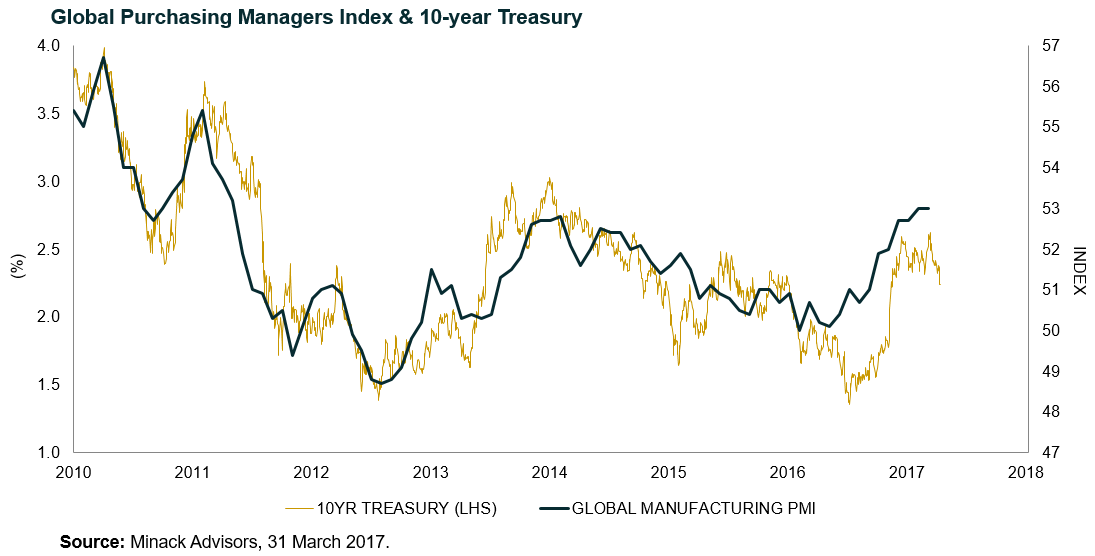In early 2016, the authorities appeared to snatch victory from the jaws of defeat. According to the World Bank, 2015 saw only the sixth year-on-year contraction in world GDP in nominal U.S.-dollar terms since records began in 1960.[1] Not only that, but the annual decline was the largest on record, at -5.5%, eclipsing even the fall of 2009.[2] Industrial commodities were collapsing, emerging-market equities were in the throes of a bear market, while yields on emerging-market debt were marching higher, as footloose international capital took flight.[3]
However, it wasn’t just emerging markets where prospects were taking a turn for the worse. By early 2016, developed-market (ex U.S.) equities were also firmly in a bear market, while high-yield credit spreads in the U.S. were blowing out.[4]
While the financial and economic stress had its locus in China and emerging markets, the catalyst was arguably the U.S. Federal Reserve’s (Fed) winding down of the third round of its quantitative-easing program. This reduced the supply of central-bank liquidity to the global financial system which, alongside the significant appreciation of the U.S. dollar from mid-2014, led to a massive tightening of global liquidity conditions.
Liquidity conditions have a habit of leading the ‘real’ economy. As cash flows deteriorated in 2015, points of balance-sheet vulnerability within the global financial system were exposed. In the face of mounting financial stress that looked set to have serious economic repercussions, the authorities responded. The Fed stepped away from further rate hikes and talked down the dollar, while the European Central Bank (ECB) ramped up its own bond-buying program. Capital flight from China and emerging markets abated, and by mid-2016 global central banks were supplying more liquidity than at any point since immediately after the global financial crisis.
A New Inflection Point?
But why does this episode warrant revisiting? Because, once again, believing the global economy to be on firmer ground, the world’s major central banks are now set to begin withdrawing monetary support.
Following their collective efforts, global liquidity conditions have been supportive of economic activity and financial markets throughout 2017, but there is reason to believe that we may be on the cusp of an inflection point when it comes to liquidity. While central banks have collectively purchased around $2 trillion of assets this year, the pace has already been declining as the Bank of Japan has reduced its monthly asset purchases in favor of ‘yield-curve control’. Central-bank liquidity provisions are set to fall further as the Fed begins the process of reducing its mammoth balance sheet, while the ECB is potentially set to taper its monthly purchases further.
The question facing investors is whether asset prices, successfully inflated with central-bank liquidity injections, can maintain rarefied levels even as that same liquidity is withdrawn. Or will the relationship between central-bank liquidity and risk assets break down?
My view is that reduced supply of central-bank liquidity, whether through reduced purchases or balance-sheet reduction is, in the absence of a private sector that is willing to increase leverage as in pre financial-crisis days, axiomatically deflationary. In due course, I believe this is likely to undermine support for risk assets, and in turn provide a further tailwind for government bonds.
[1] https://data.worldbank.org/indicator/NY.GDP.MKTP.CD
[2] Ibid
[3] Source: Thomson Reuters Datastream, 08.31.17
[4] Ibid
This is a financial promotion. Compared to more established economies, the value of investments in emerging markets may be subject to greater volatility owing to differences in generally accepted accounting principles or from economic, political instability or less developed market practices. Material in this publication is for general information only. The opinions expressed in this document are those of Newton and should not be construed as investment advice or recommendations for any purchase or sale of any specific security or commodity. Certain information contained herein is based on outside sources believed to be reliable, but its accuracy is not guaranteed. You should consult your advisor to determine whether any particular investment strategy is appropriate. This material is for institutional investors only. Any reference to a specific security, country or sector should not be construed as a recommendation to buy or sell this security, country or sector. Please note that strategy holdings and positioning are subject to change without notice.
Important information
This is a financial promotion. Issued by Newton Investment Management Limited, The Bank of New York Mellon Centre, 160 Queen Victoria Street, London, EC4V 4LA. Newton Investment Management Limited is authorized and regulated by the Financial Conduct Authority, 12 Endeavour Square, London, E20 1JN and is a subsidiary of The Bank of New York Mellon Corporation. 'Newton' and/or 'Newton Investment Management' brand refers to Newton Investment Management Limited. Newton is registered in England No. 01371973. VAT registration number GB: 577 7181 95. Newton is registered with the SEC as an investment adviser under the Investment Advisers Act of 1940. Newton's investment business is described in Form ADV, Part 1 and 2, which can be obtained from the SEC.gov website or obtained upon request. Material in this publication is for general information only. The opinions expressed in this document are those of Newton and should not be construed as investment advice or recommendations for any purchase or sale of any specific security or commodity. Certain information contained herein is based on outside sources believed to be reliable, but its accuracy is not guaranteed. You should consult your advisor to determine whether any particular investment strategy is appropriate. This material is for institutional investors only.
Personnel of certain of our BNY Mellon affiliates may act as: (i) registered representatives of BNY Mellon Securities Corporation (in its capacity as a registered broker-dealer) to offer securities, (ii) officers of the Bank of New York Mellon (a New York chartered bank) to offer bank-maintained collective investment funds, and (iii) Associated Persons of BNY Mellon Securities Corporation (in its capacity as a registered investment adviser) to offer separately managed accounts managed by BNY Mellon Investment Management firms, including Newton and (iv) representatives of Newton Americas, a Division of BNY Mellon Securities Corporation, U.S. Distributor of Newton Investment Management Limited.
Unless you are notified to the contrary, the products and services mentioned are not insured by the FDIC (or by any governmental entity) and are not guaranteed by or obligations of The Bank of New York or any of its affiliates. The Bank of New York assumes no responsibility for the accuracy or completeness of the above data and disclaims all expressed or implied warranties in connection therewith. © 2020 The Bank of New York Company, Inc. All rights reserved.







